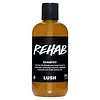What's inside
What's inside
 Key Ingredients
Key Ingredients

No key ingredients
 Benefits
Benefits

No benefits
 Concerns
Concerns

 Ingredients Side-by-side
Ingredients Side-by-side

Sodium Lauryl Sulfate
CleansingChondrus Crispus Extract
Skin ConditioningWater
Skin ConditioningAmmonium Laureth Sulfate
CleansingCocamide Mea
EmulsifyingParfum
MaskingCarica Papaya Fruit Juice
HumectantPropylene Glycol
HumectantSea Salt
AbrasiveMangifera Indica Juice
Skin ConditioningSimmondsia Chinensis Seed Oil
EmollientOlea Europaea Fruit Oil
MaskingPrunus Amygdalus Dulcis Oil
Skin ConditioningLavandula Angustifolia Oil
MaskingMentha Piperita Oil
MaskingRosmarinus Officinalis Leaf Oil
MaskingJuniperus Communis Fruit Oil
MaskingLimonene
PerfumingLinalool
PerfumingBenzyl Alcohol
PerfumingMethylparaben
PreservativePropylparaben
PreservativeSodium Lauryl Sulfate, Chondrus Crispus Extract, Water, Ammonium Laureth Sulfate, Cocamide Mea, Parfum, Carica Papaya Fruit Juice, Propylene Glycol, Sea Salt, Mangifera Indica Juice, Simmondsia Chinensis Seed Oil, Olea Europaea Fruit Oil, Prunus Amygdalus Dulcis Oil, Lavandula Angustifolia Oil, Mentha Piperita Oil, Rosmarinus Officinalis Leaf Oil, Juniperus Communis Fruit Oil, Limonene, Linalool, Benzyl Alcohol, Methylparaben, Propylparaben
Water
Skin ConditioningSodium Lauryl Sulfate
CleansingSodium Laureth Sulfate
CleansingSodium Chloride
MaskingGlycol Distearate
EmollientZinc Carbonate
Sodium Xylenesulfonate
Dimethicone
EmollientZinc Pyrithione
AntiseborrhoeicCocamidopropyl Betaine
CleansingParfum
MaskingSodium Benzoate
MaskingGuar Hydroxypropyltrimonium Chloride
Skin ConditioningHexyl Cinnamal
PerfumingLinalool
PerfumingMagnesium Carbonate Hydroxide
BufferingMethylchloroisothiazolinone
PreservativeMethylisothiazolinone
PreservativeCI 42090
Cosmetic ColorantCI 17200
Cosmetic ColorantWater, Sodium Lauryl Sulfate, Sodium Laureth Sulfate, Sodium Chloride, Glycol Distearate, Zinc Carbonate, Sodium Xylenesulfonate, Dimethicone, Zinc Pyrithione, Cocamidopropyl Betaine, Parfum, Sodium Benzoate, Guar Hydroxypropyltrimonium Chloride, Hexyl Cinnamal, Linalool, Magnesium Carbonate Hydroxide, Methylchloroisothiazolinone, Methylisothiazolinone, CI 42090, CI 17200
Alternatives
Ingredients Explained
These ingredients are found in both products.
Ingredients higher up in an ingredient list are typically present in a larger amount.
Linalool is a fragrance and helps add scent to products. It's derived from common plants such as cinnamon, mint, citrus, and lavender.
Like Limonene, this ingredient oxidizes when exposed to air. Oxidized linalool can cause allergies and skin sensitivity.
This ingredient has a scent that is floral, spicy tropical, and citrus-like.
Learn more about LinaloolParfum is a catch-all term for an ingredient or more that is used to give a scent to products.
Also called "fragrance", this ingredient can be a blend of hundreds of chemicals or plant oils. This means every product with "fragrance" or "parfum" in the ingredients list is a different mixture.
For instance, Habanolide is a proprietary trade name for a specific aroma chemical. When used as a fragrance ingredient in cosmetics, most aroma chemicals fall under the broad labeling category of “FRAGRANCE” or “PARFUM” according to EU and US regulations.
The term 'parfum' or 'fragrance' is not regulated in many countries. In many cases, it is up to the brand to define this term.
For instance, many brands choose to label themselves as "fragrance-free" because they are not using synthetic fragrances. However, their products may still contain ingredients such as essential oils that are considered a fragrance by INCI standards.
One example is Calendula flower extract. Calendula is an essential oil that still imparts a scent or 'fragrance'.
Depending on the blend, the ingredients in the mixture can cause allergies and sensitivities on the skin. Some ingredients that are known EU allergens include linalool and citronellol.
Parfum can also be used to mask or cover an unpleasant scent.
The bottom line is: not all fragrances/parfum/ingredients are created equally. If you are worried about fragrances, we recommend taking a closer look at an ingredient. And of course, we always recommend speaking with a professional.
Learn more about ParfumSodium Lauryl Sulfate (SLS) is a sulfate with surfactant properties.
The surfactant property make it a great foam creator and cleansing agent. Surfactants help bind ingredients that normally do not mix.
Some studies have shown skin irritation due to prolonged SLS use.
Sodium Laureth Sulfate (SLES) is a milder version of SLS.
Learn more about Sodium Lauryl SulfateWater. It's the most common cosmetic ingredient of all. You'll usually see it at the top of ingredient lists, meaning that it makes up the largest part of the product.
So why is it so popular? Water most often acts as a solvent - this means that it helps dissolve other ingredients into the formulation.
You'll also recognize water as that liquid we all need to stay alive. If you see this, drink a glass of water. Stay hydrated!
Learn more about Water